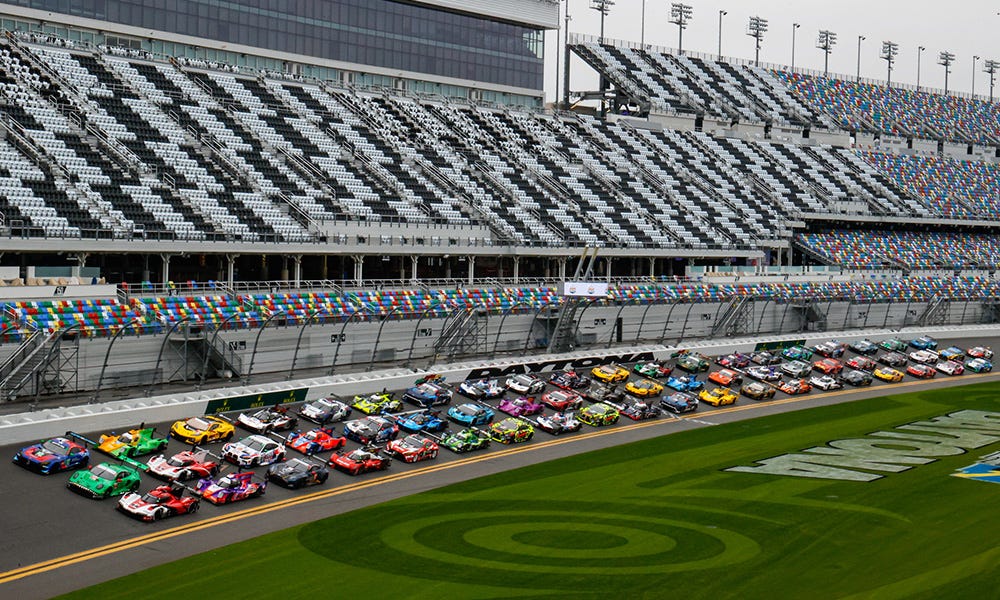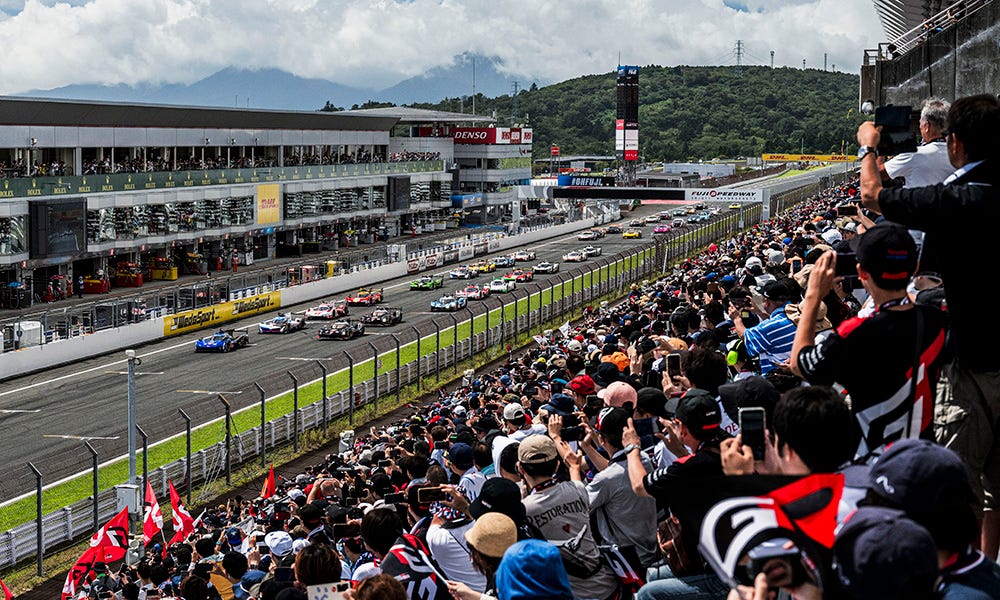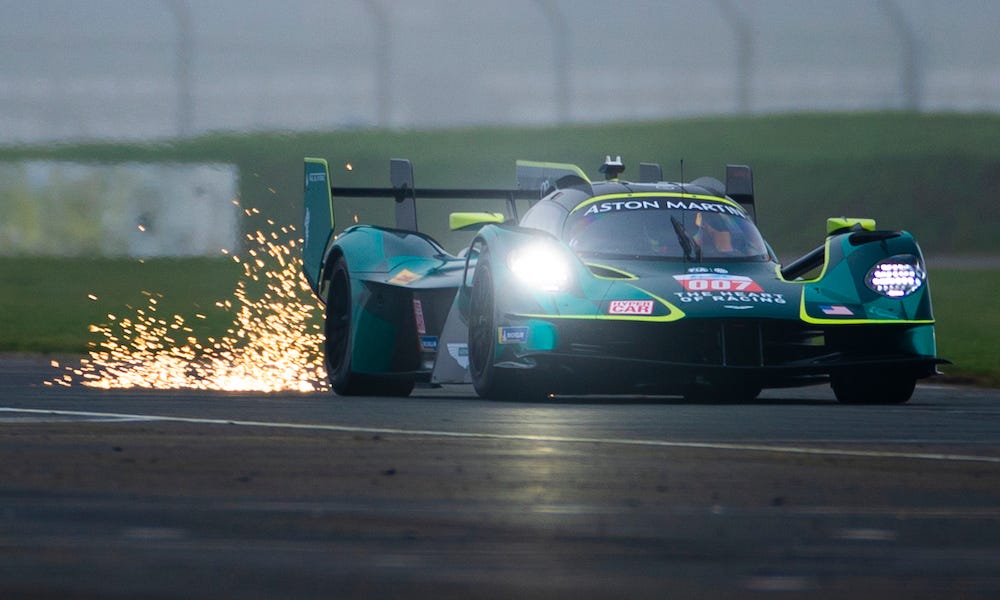Opinion: Entering the 'Platinum Era' of Sports Car Racing
John Dagys on sports car racing's continued growth, with even more recent top-class manufacturer commitments...
Last month’s IMSA WeatherTech SportsCar Championship season-opening Rolex 24 at Daytona again attracted a sold-out grid of top-level sports cars, coupled with what appeared to be another spectator attendance record that packed the Daytona International Speedway infield to the brim.
Global sports car racing convergence, a concept announced just over five years ago, became a reality in 2023 with the launch of IMSA and the ACO’s LMDh prototype platform, enabling manufacturers such as Porsche and Cadillac to compete in both the WeatherTech Championship and FIA World Endurance Championship with the same car.
While four manufacturers initially signed up to build LMDh machinery, that number has doubled in just a few short years, following recent confirmations from Hyundai’s luxury brand Genesis, as well as Ford, which will return to fight for overall victories in the 24 Hours of Le Mans beginning in 2027.
With other brands such as Acura, Alpine, BMW and Lamborghini all committed to the platform, along with cars from Ferrari, Peugeot, Toyota and new-for-2025, Aston Martin, built to the LMH set of regulations, sports car racing hasn’t seen this level of manufacturer involvement, ever.
And it’s not likely to stop at 12 brands, as McLaren is reportedly preparing a LMDh project of its own, rumored for a 2027 launch.
To quote IMSA President John Doonan, we’re quickly moving from the ‘Golden Era’ to the ‘Platinum Era’ of sports car racing, with more than a dozen OEMs to potentially be represented on the grids of the WEC and WeatherTech Championship in the years to come.
The step up in prototype car counts — WEC has had to increase its full season grid capacity due to the anticipation of more manufacturers joining in the years to come — has been noticeable in both championships, but we’ve also seen boosts in the GT ranks, particularly following the demise of the GTE platform, which has seen manufacturers rally around the globally popular GT3 formula.
Many of SRO Motorsports Group’s championships, including GT World Challenge Europe and Asia, have seen capacity grids, while GT-only events such as the CrowdStrike 24 Hours of Spa and Nürburgring 24 have continued to gain worldwide attention and popularity.
Single-make series from Porsche, Lamborghini, Ford and Ferrari continue to skyrocket too, fostering up-and-coming talent as well as aspiring amateur racers looking to one day achieve their dreams of taking part in Daytona and/or Le Mans.
From every level, the sport hasn’t been so healthy before, especially at a time of change in the automotive industry, with a shift towards hybrid and electric vehicle technology, the latter which hasn’t fully taken hold as many had initially expected it to be by now.
While an EV sports car racing series, in turn, also has yet to take off, all of the major governing bodies: FIA, ACO, IMSA and SRO, have been keeping a close eye on the developments in the world, which, for now, still appears to still be embracing fire-breathing, ear-popping sports cars.
One example is the V12-powered Aston Martin Valkyrie AMR-LMH, which is set for its highly anticipated race debut in this month’s WEC season-opening Qatar 1812km, before making its first competitive appearance on North American soil at the Mobil 1 Twelve Hours of Sebring next month.
It will represent the first non-hybrid car built to LMH regulations from an OEM, and also the first utilizing the underpinnings of the FIA and ACO’s production-based sub-rulset. And it will also be the first LMH car to compete in the WeatherTech Championship altogether.
The level of diversity in the top prototype class, whether it’s called Hypercar or GTP, is unmatched in any form of motorsport. From LMDh machinery featuring V8 twin-turbos, to normally aspirated V8s and V6 turbos to advanced four-wheel drive LMHs, also with a variety of powerplants and unique hybrid systems, there’s something for everyone.
Growing up as an avid sports car racing fan in the mid-to-late 90s, was a turbulent time for the sport. From numerous and often confusing sets of regulations to the evolutions of governing bodies, it was a tough time to follow and fully understand the nature of endurance racing.
Nearly three decades later, sports car racing can still be somewhat confusing for the multitudes of regulations added over the years, such as Balance of Performance, driver ratings and so-on, but there’s a clear direction and message being sent to the next generation of the sport, and that’s embracing the many different types of cars, the manufacturer support and the entertaining competition it produces.
The 1999 running of Le Mans marked a high-point for top-class prototype involvement with ten OEMs, boutique manufacturers or racing constructors competing in the top classes, and while this year’s running will welcome an eighth brand in Aston Martin, more are on the way, with Genesis set to debut next year, followed by Ford and McLaren.
As we know in the cyclical nature of motorsport, this ‘Platinum Era’ won’t last forever, but we better embrace it, because right now, we’re all part of making sports car racing history.
Photos: Jake Galstad/IMSA, Charly Lopez/DPPI, Drew Gibson/AMR, Mike Levitt/IMSA








Another excellent piece by John. I would add that sports car racing is doing an excellent job of focusing on the confluence between the technical and the human. The presence of OEMs in both proto & GT is big plus, as a is BOP to keep the races close, a continuity of rules, race dates, and venues to make the explanation and experience easy. The paddock experience is far, far better than in any other series, which humanizes not just the drivers but the crews. Especially for kids, this is mesmerizing. The tie-ins with education are well appreciated. Even the "Corvette Finger" helps, creating rivalries. Perhaps what I like best is that it has been done without dumbing down the sport as often happens elsewhere. Indeed, it's the opposite. Challenging spectators to learn and they seem to like it.
After attending the most recent Rolex 24 at Daytona over all 4 days, the noticeable increase in younger fans and families present was evident since 2018 when I first came with my oldest son. Rexy and other kid-friendly aspects of the access that current IMSA events permit are a big factor contributing to that popularity among race fans.